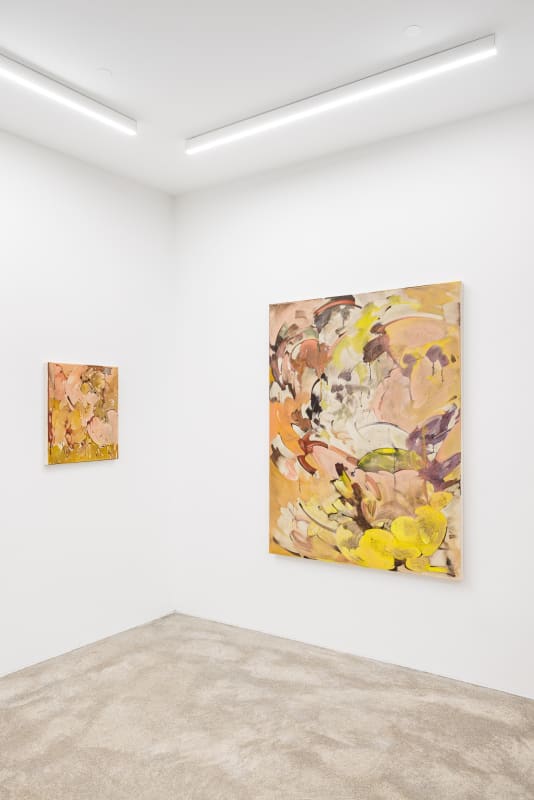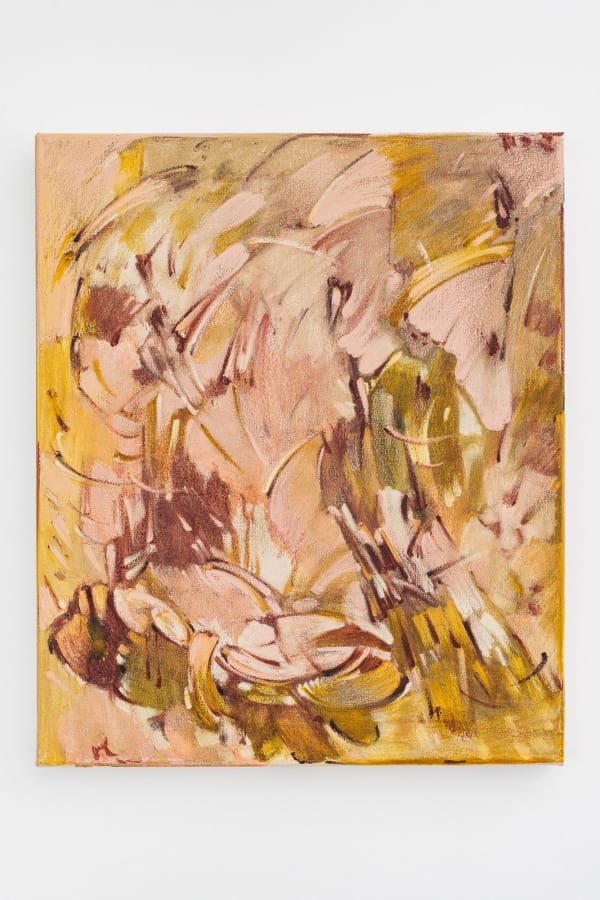Kaifan Wang: Bull Washer
Previous exhibition
Text
Kaifan Wang’s chosen title for his first exhibition in Austria - Bull Washer - derives from the legend which supposedly took place during an ancient siege of Salzburg in which the people pretended not to suffer from starvation by painting a bull in different colours to prove an abundance of supplies. However, the main relation is the aspect of the later washing of the bull in the river as a gentle gesture of protection, gratitude and recreation. Through this, Wang’s paintings and videos focus on the thematical approach of erasure and the application of these elements within two differentiating cultural boundaries.
The most direct relation to the titular tale is the video Look Back, which endlessly loops a Mongolian bull in the outskirts of Hohhot, the capital of Inner Mongolia and Wang’s hometown, seen from the main highway. The plain directness of the motionless bull as an agrarian symbol for the politically charged landscape of Inner Mongolia, being defined by Han Chinese as well as Mongolian cultures, delivers a monument of stability and local identify. This stands in contrast to the video Bull Washer, where the act of erasure is explored through performative painterly gestures of a brush wiping the snow from the walls at Teufelsberg in Berlin. The site of Teufelsberg is a non-natural hill created in the twenty years following the end of the Second World War, consisting of rubble moved from the destroyed buildings of West Berlin. The site itself is unique in Germany as the rubble covers the incomplete construction of a Nazi military college designed by Albert Speer which the allies were unable to destroy with explosives and thus chose to cover with the debris. The video sequences the alternation between aggressive sweeping of snow from the main walls to unveil its underlying structures, contrasted by the intimate stillness in the woods and the gentle movements of taking off layers of snow from frozen blossoms and twigs nearby.
These elements of historical and cultural effacing and the dichotomy between the aggressive components with a gentler erosive act of erasure are key to the thematic and technical aspects of Wang’s painting practice. The gestural movements from which the layers of paint are composed upon the canvas are then left to dry and scratched from the surface, creating a process of removal that retains an echo of the previous action and colour. The compositions seem to wander and aim for an exterior position outside the limitation of the image and the dripping effects add to the fluidity of the historical references and aspects of time that mutates and abstracts.
The contradictions within the emotive gestures lead into a dialogue between the traditions of abstraction within Western and Chinese painterly techniques. In this regard, Wang is interested in the violent and dominant movements that have a prevalence within the western canon of abstract painting with bold colour fields applied as if with force. However, simultaneously the works possess an aqueous quality that feels bequeathed from the traditions of Chinese ink painting, with a flowing constitution moving through the dilution of colour across the strokes of paint. The integration of these aspects and the interrogation of the duality of their cultural signifiers and displacements, ultimately encapsulates the essence of Wang’s practice, through the tender exploration of both his own cultural identity and a wider interest in the manner through which we construct and erase ancestral histories.
The most direct relation to the titular tale is the video Look Back, which endlessly loops a Mongolian bull in the outskirts of Hohhot, the capital of Inner Mongolia and Wang’s hometown, seen from the main highway. The plain directness of the motionless bull as an agrarian symbol for the politically charged landscape of Inner Mongolia, being defined by Han Chinese as well as Mongolian cultures, delivers a monument of stability and local identify. This stands in contrast to the video Bull Washer, where the act of erasure is explored through performative painterly gestures of a brush wiping the snow from the walls at Teufelsberg in Berlin. The site of Teufelsberg is a non-natural hill created in the twenty years following the end of the Second World War, consisting of rubble moved from the destroyed buildings of West Berlin. The site itself is unique in Germany as the rubble covers the incomplete construction of a Nazi military college designed by Albert Speer which the allies were unable to destroy with explosives and thus chose to cover with the debris. The video sequences the alternation between aggressive sweeping of snow from the main walls to unveil its underlying structures, contrasted by the intimate stillness in the woods and the gentle movements of taking off layers of snow from frozen blossoms and twigs nearby.
These elements of historical and cultural effacing and the dichotomy between the aggressive components with a gentler erosive act of erasure are key to the thematic and technical aspects of Wang’s painting practice. The gestural movements from which the layers of paint are composed upon the canvas are then left to dry and scratched from the surface, creating a process of removal that retains an echo of the previous action and colour. The compositions seem to wander and aim for an exterior position outside the limitation of the image and the dripping effects add to the fluidity of the historical references and aspects of time that mutates and abstracts.
The contradictions within the emotive gestures lead into a dialogue between the traditions of abstraction within Western and Chinese painterly techniques. In this regard, Wang is interested in the violent and dominant movements that have a prevalence within the western canon of abstract painting with bold colour fields applied as if with force. However, simultaneously the works possess an aqueous quality that feels bequeathed from the traditions of Chinese ink painting, with a flowing constitution moving through the dilution of colour across the strokes of paint. The integration of these aspects and the interrogation of the duality of their cultural signifiers and displacements, ultimately encapsulates the essence of Wang’s practice, through the tender exploration of both his own cultural identity and a wider interest in the manner through which we construct and erase ancestral histories.
Installation Views
Works
Video
Look Back, 2023, video, colour
'Look Back', loops footage of a Mongolian bull in the outskirts of Hohhot, the capital of Inner Mongolia and Wang’s hometown, seen from the main highway. The plain directness of the motionless bull as an agrarian symbol for the politically charged landscape of Inner Mongolia, being defined by Han Chinese as well as Mongolian cultures, delivers a monument of stability and local identify.
Bull Washer, 2024, video, colour, sound.
Through the video work 'Bull Washer', the act of erasure is explored through performative painterly gestures of a brush wiping the snow from the walls at Teufelsberg in Berlin. The site of Teufelsberg is a non-natural hill created in the twenty years following the end of the Second World War, consisting of rubble moved from the destroyed buildings of West Berlin. The site itself is unique in Germany as the rubble covers the incomplete construction of a Nazi military college designed by Albert Speer which the allies were unable to destroy with explosives and thus chose to cover with the debris. The video sequences the alternation between aggressive sweeping of snow from the main walls to unveil its underlying structures, contrasted by the intimate stillness in the woods and the gentle movements of taking off layers of snow from frozen blossoms and twigs nearby.










